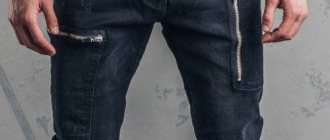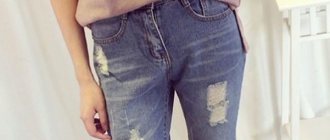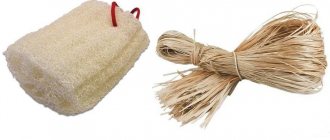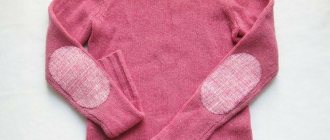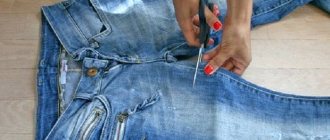For more than a century and a half, jeans have not gone out of fashion. Tastes change, preferences and models change, but the basics remain the same. The clothes are simple and versatile; moreover, they are so comfortable that they become a “second skin” for the wearer.
And how frustrating it is for the owner to see scuffs and tears in his favorite pants. It's a shame to throw it away, but it's inconvenient to wear.
What material to use for the patch
A patch on jeans (fabric most often tears on the knee) not only hides the defect, it can be used as a finishing element. Denim trousers go well with different colors and textures. Depending on the model and purpose of the pair, a patch option is selected.
Fabric from jeans
Classic denim trousers can be combined with items of different shades and styles. To prevent the patch from standing out, it is cut out from the fabric of the trousers. It’s good if the fabric is preserved after shortening the pair.
The second option for a patch made from native fabric is the area under the back pocket. Any other fabric of similar density is sewn in place of the cut fabric.
Adhesive fabric
Minor damage and abrasions are fixed with adhesive material. Thick cotton adhesive with a dotted coating of adhesive is suitable.
For duplication, a part is prepared that is wider and longer than the damaged area. If you carefully make a patch from adhesive fabric, the work will be unnoticeable. It is not always necessary to hide traces of repairs.
Thermal patches
A patch on jeans on the knee or other part of the trousers, made in the form of embroidery, plays the role of finishing.
Embroidered pictures on fabric impregnated with textile glue on the reverse side are available in different colors and themes. On sale there are pictures from popular children's cartoons, army symbols, flowers, animals, birds.
The size of the thermal patch should be a couple of centimeters larger than the tear site. The damage is fixed with light stitches without tension. The trim is glued using a hot iron with steam for a few minutes.
Lace, colored, leather options
Depending on what type of clothing trousers are most often worn with, patches made from a material other than denim are selected.
| Pants model and denim color | Patch material and color | Top of the set |
| Blonde boyfriends; White jeans | White thick lace, white coarse mesh | White shirt or tank top |
| Black | Black lace, black leather | Biker jacket, white shirt |
| Blue Boyfriends; cropped jeans | Colored cell; black fabric | Biker jacket, white shirt |
| Blue slim mom cropped jeans | Floral fabric | Plain colored T-shirt; floral blouse |
| Blue; black | Fabric with sequins | Silk blouse, T-shirt with sequin appliqué |
The fabric with a pattern selected for the patch should not repeat the top of the set. It is enough for one color or shade to be common.
Machine embroidery, stripes
The proliferation of embroidery machines allows anyone to order embroidery on jeans according to their taste. After its completion, there will be no trace left of the damage that caused the transformation.
Machine embroidery is done with silk threads; the color and design can be chosen from those offered in the atelier. An alternative to machine embroidery can be a patch made from embroidery made on a different fabric.
Repairing holes
Let's move on to more complex objects - holes!
Stocking up:
- Threads in color, if there is no color in color, then take threads a little darker, they are less noticeable.
- A piece of fabric is the same. Maybe you shortened your jeans, maybe you have jeans of the same color and you don’t mind cutting them.
From the outside, we look at the hole in the jeans and use scissors to cut off the fringe as much as possible. We don’t make the hole bigger, but rather trim it! When broken threads stick out, it is very noticeable. If you cut this fringe, the look is immediately neater.
We substitute our piece. See for yourself - you can put a patch on top, covering the tear. The piece of fabric should be 1-2 cm larger than the hole. If there is a large hole on your jeans and several small ones nearby, it is better to place a piece of fabric from the inside and fill the place of the former hole with a machine.
How to piece, see above in the text.
What to do if the same fabric is not available
You and I know that there are no hopeless situations, we’ll look for fabric color-matched, it could be chintz or knitwear, we’ll place it on the back side of the hole so that the side that most matches the color is looking into the hole, and we’ll do the piece in the same way .
What to do if it is torn thoroughly and on a large plane
In pants, the area between the legs is the most vulnerable spot. We make a large and thorough patch. You will need material in denim color to match. We cut out a triangle on the patch from the ischial seam, along the side seam to the desired length. The second similar piece is mirrored.
This patch is applied only on the outside, as if it were a decorative element. Therefore, it is important to take into account the material for the hem, approximately 0.5 cm on each side. We sew our triangles on top to the problem area.
DIY patch on jeans using a sewing machine
Most people have a good sewing machine in their home; having one allows you to independently repair your favorite pair of denim trousers. The more special operations the machine performs, the more interesting the result will be.
In addition to the sewing machine, for work you need to prepare:
- repair material;
- ruler and centimeter;
- threads of a color similar to the fabric of the trousers;
- sharp scissors for small jobs;
- cutting scissors;
- ripper;
- tailor's pins;
- adhesive fabric.
All preparation work is carried out on a table, in good lighting.
How to do the thing
A patch on jeans (on the knee, between the legs, under the knee) is most often done using the plastering method. The method will hide abrasions and strengthen the fabric of nearby areas of the product.
It is performed in the following order:
- A patch of a similar configuration and larger size than the damaged area is cut out.
- Using an overlocker or a zigzag sewing machine, the edge of the patch is sewn.
- From the reverse side, using an adhesive web, the patch is glued to the duplicated area.
- The sewing machine is threaded with denim-colored threads.
- First, the stitching is done in the direction opposite to the position of the fabric hem. The distance between lines can be about 0.7 cm.
- The stitching in the direction of the hem of the denim closes the lines of the first operation and is performed much thicker - 0.3-0.2 cm.
- Depending on the degree of damage, the stitching can be more or less dense.
Properly executed gizmo is almost invisible and allows you to extend the life of the pair without changing the appearance.
Japanese technique "Boro"
The technique originated in the Middle Ages in the Land of the Rising Sun. Boro art consists of numerous parallel stitches of equal length, hand-crafted. They resemble darning with coarse threads. For ease of use, needlewomen advise using long needles.
- To repair damage to jeans, choose thin denim, cotton or linen fabric.
- To work, choose a flap of any shape. The seam allowance should be 3-4 cm.
- Finish the outline of the cut or hole with forward stitches using a needle. In this case, the damage will not stretch further.
- Parallel to the outline of the hole, use a washable felt-tip pen to draw parallel lines for future embroidery. The distance between them can be 0.6-0.8 cm.
- From the wrong side, baste the prepared patch.
- Apply smooth stitches along the marked lines, which should be longer on the front side than on the back side.
- You need to turn the stitch onto the next row from the wrong side. Continue embroidering in the opposite direction.
- Make several rows of stitches on the bottom and top of the patch of different lengths, as well as on the sides.
The cuts on the flap can be slightly frayed if the flap is sewn on the front side of the product. To add style to the patch, you need to choose different stitch lengths and thread colors.
Video about Boro technique
How to beautifully sew a tear in fabric or a seam on the knee
A patch on jeans on the knee of one leg or both is performed in the following sequence:
- The trouser leg in the knee area is the narrowest. For ease of work, the outer side seam, which does not have a finishing stitch, is ripped open from the bottom to the middle of the thigh.
- So that the patch does not interfere with the dynamics, the fabric is chosen to be loose, a little thinner than on the trousers. The shape of the patch can be any: square, oval or diamond.
- The patch is pinned to the knee of the jeans and adjusted using a sewing machine. The part allowance is cut off by 3 mm.
- Using a thick zigzag stitch, the patch is processed around the perimeter in such a way that the straight stitching line and the cut allowance are hidden.
Threads for finishing stitching are selected to match the tone of the fabric or a contrasting color.
Ripped jeans
Jeans usually tear in the same places, so for each defect a certain type of patch is selected, which in one case or another may or may not be noticeable.
The most common problem occurs in the knee area and pant leg separation. If it is completely impossible for the knees to patch up a hole in such a way that it is not visible even with the most delicate approach, then the area between the legs is subject to careful restoration in such a way that no one will guess that there was a tear there.
For work, it is recommended to use a sewing machine, because with it the seams will turn out neat and invisible, and you can only do big troubles with your hands, especially if you have no experience in this matter.
In addition to a sewing machine, you will always need a patch to match the color of your jeans, threads of the same color or similar, scissors and safety pins.
How to sew decorative elements
Leisure clothing and children's jeans are often decorated with decorative stripes and embroidery. Damage to the fabric can also be covered with a colored patch; clothing design will only benefit from this.
Decorative elements can be sewn in different ways:
- by hand with neat small stitches;
- colored zigzag and straight stitch along the perimeter of the patch.
It will be good if the decorative stripes are matched in style with the existing ones. On trousers without stripes, you will have to create the design yourself. Some of the stripes will hide defects, while some will be sewn on only for decoration.
Stage 5: Strengthen the hole
This step is optional, but I decided to sew it up just in case because it will prevent the hole from coming apart and will hold the middle of the patch firmly against the surface of the jeans. Ordinary stitching around the perimeter of the hole.
Don't forget to make a knot between the patch and the jeans.
Here. The results were beautifully repaired jeans!
Nowadays it is difficult to find a person who does not own jeans. These are very practical and stylish clothes. The fashion for jeans in our country has been around for a long time. Now they are very popular due to their versatility and ease of wear. You can wear them almost without taking them off. Both at work and on vacation they will always be appropriate. But over time, with prolonged wear, the fabric wears out and your favorite denim trousers tear. Because of this, they look sloppy and sloppy. Don't rush to throw them away, as they can be repaired. We'll talk about the one on the jeans now.
What to make the patch from?
It’s very good if you still have scraps of fabric. They usually remain after the length is reduced. When buying trousers in a reputable store, a piece of fabric is usually included with the tag, which can be used as a patch. Don't have any of the above on hand? Then the patch can be cut from any old jeans. Skirts, jackets and others made from this fabric are also suitable for this purpose. The main thing is that it is as similar in color and texture as possible to the jeans you want to sew.
How to prepare a patch?
Now you can start restoring your favorite trousers
If a pocket, a tab, or a belt loop get in the way of mending your jeans, then you need to carefully rip them off, bend them back and pin them. First, you should use chalk around the torn area to outline an outline slightly larger than the hole.
If there are areas nearby that are already very worn out and will soon tear, then they also need to be outlined. A patch is cut out of the fabric. It is then overcast by hand or using a sewing machine.
How to sew a patch?
The finished patch should be applied to the inside of the jeans in the chalk-marked place and pinned with pins or basted with large stitches. After this, it must be stitched on the machine using a zigzag seam. Before doing this, the trousers should be turned inside out. The front side should be down. Then we turn them inside out again. Places where small abrasions or tears are noticeable should be mended using a sewing machine using back-and-forth stitches. The color of the threads should ideally match the jeans. If you don't have a sewing machine, small holes can be sewn up by hand. On the front side, the holes are sewn with small stitches, the direction of which coincides with the direction of the fabric pattern. The lines must be placed very close to each other. After darning the trousers, the excess fabric must be cut off. That's all. We figured out how to sew up a hole in jeans. The sewn patch looks neat and unnoticeable. And your favorite denim trousers will last you for several more years.
How to sew up holes in children's jeans?
For mothers with small children, especially sons, the problem of how to sew up a hole in their jeans arises especially often. After all, kids fall, climb slides on their knees, crawl on playgrounds. Therefore, holes most often appear on the knees. After this, the trousers lose their appearance. To repair them, you can use thermal decal, which will not only cover the torn area, but also serve as a wonderful decoration. To begin with, from the wrong side, the hole must be reinforced with a small piece of dublerin, glued with a hot iron. Then the selected applique should be placed on the front side of the hole, and the adhesive web should be placed on top. And all this needs to be ironed with a very hot iron. Just in case, you can sew along the contour of the applique by hand or on a sewing machine. And then the problem of how to sew up a hole in your jeans will disappear for a long time.
How to install an invisible patch
For an inconspicuous patch, select a fabric similar to the material of the trousers. The damage site is cut out in the shape of an oval or square. The patch follows the shape of the cut out part, but is larger by the amount of allowance. The direction of the warp thread on the trouser leg and the patch must match, so the result of the repair will be barely noticeable.
The blank is placed under the trouser part and adjusted with a straight stitch. The allowance is cut off by 0.3 cm and secured with a small zigzag. The closer the threads of the last line are in color to the material of the trousers, the more invisible the work will be.
How to do without a patch
A small damage that still has threads can be sewn up without using a patch. To secure the repaired area, an adhesive insert slightly larger than the wiped area is used. The duplicating fabric is glued from the inside out using a hot iron.
The front side is machined. Threads of stitching of a suitable color fasten the damaged area and the adhesive fabric; the thicker the zigzag of the stitching, the stronger the repair result will be.
The use of thermal drawing will help you do without a patch. First you need to make a stencil. The paint used is special, acrylic. As a result, a defect carefully fixed by any method (except for a patch) will be completely invisible thanks to the bright pattern. Turning your trousers into shorts will help you get by without a patch.
How to decorate a hole?
This process is the most favorite among tailors; here you can fantasize as much as you like!
Using a factory application:
- apply adhesive cloth to the tear;
- Place the applique on it if the applique does not have an adhesive base;
- iron;
- To prevent it from coming off when washing, make a few stitches around the perimeter by hand or sew on a machine.
How to beautifully hide damage to denim above the knee
Damage above the knee during movement has less impact on the comfort of the trousers. The patch in this part of the trouser leg can be made from any fabric. The requirements for strength and ergonomics are much lower than for a knee injury.
Beautiful options for this area:
- Lace fabric stitched on the reverse side. The beautiful finish can be repeated on another leg.
- Colored fabric with a pattern. A fabric patch with a checkered pattern looks stylish.
For a more dramatic look, the damaged area can be cut out much larger than the size of the damage. The edges can be ruffled; the same treatment is used on the bottom of denim trousers.
If the material breaks vertically, the defect can be turned into a pocket with a metal zipper:
- From a similar or finishing fabric, 2 strips of pocket blanks are cut into a frame.
- The cut on the trousers is fixed with adhesive on the reverse side.
- The pocket facings folded in half are adjusted “into a frame”.
- The pocket is cut and turned inside out.
- On the reverse side there is a zipper located in the center.
- The zipper is sewn on at the same time as the pocket burlap.
- The pocket burlap pieces are sewn together. The seam is overcast.
Patches for jeans in the form of pockets with zippers
You can make a patch pocket by first fixing the damage with adhesive and lightweight stuff.
Darning by hand
More skill and patience will be required for manual repairs.
For a hole in the shape of a rectangle, hand darning is used:
- A thread of a suitable color must be threaded into the needle twice.
- Having secured the thread on one side of the rectangular hole, you need to stretch it to the opposite side and secure it with one stitch.
- The thread is fixed again on the first side and so on until the entire “window” of the hand patch is filled.
- In the second direction, a needle and thread alternately interweaves threads in the opposite direction. The result is a dense mesh. It hides the defect and serves as finishing.
Socks were previously darned this way. The patches looked beautiful and spoke of the woman's skill.
Why do you need a thermal adhesive?
This patch is a lifesaver for those who want to refresh their boring wardrobe without significant financial investments.
Thermal decal is an inexpensive and effective way to revive your favorite item. This is especially true for children's clothing. Images of your favorite fairy-tale characters will help you disguise stains and cuts on children's T-shirts and save the family budget.
Using thermal stickers, you can diversify not only your wardrobe, but also your interior. If you stick a patch on decorative pillows, curtains, bedspreads, the interior will immediately turn into exclusive.
How to quickly close torn areas if there is no time
The process of darning jeans or sewing on a patch takes a long time or requires the use of a sewing machine. If you don’t have the time and the necessary equipment, you can decorate the damaged area on your knee with a sticker made of Swarovski crystals.
There are ready-made drawings on sale; they are the easiest to work with. It is enough to choose a drawing of a suitable theme and size. You can buy rhinestones coated with adhesive and make a design out of them yourself.
All work takes place in several steps:
- The damaged area is cut out. A patch of similar fabric is placed underneath.
- The edges of the lower part are glued with adhesive web or sewn around the perimeter.
- A pattern of rhinestones is laid out on the area to be covered. Cover with a piece of fabric and fix the temperature of the iron.
- The trousers are turned inside out and the area to be treated is carefully ironed from the wrong side.
Thermal patches are a kind of lifesaver when you don’t have enough time for lengthy repairs. The procedure for working with them is the same as with a pattern made of rhinestones. The quality of the repair depends on the mode of the iron and the time of its exposure. You can check the quality of gluing after the area being ironed has completely cooled.
Rules of care
To ensure that the thermal adhesive lasts as long as possible, you must adhere to the following recommendations:
- It is better to wash a product with a patch by hand. Or, if we use a washing machine, we need to choose the appropriate gentle mode.
- The water temperature should not be higher than 40°C.
- Since most patches are bright, you may want to avoid using bleach.
- The product with the applique should be dried on a flat surface.
- It is better to iron such things either from the wrong side or through gauze.
Ideas for the most beautiful and stylish patches
Depending on the purpose of the denim trousers, the embroidery pattern and the type of patch material are selected.
For boys and girls
Children's clothing is bright; patches made from multi-colored pieces of durable fabric can be used to decorate it. All seams must be strong, there should be no protruding threads, fringes or buttons for decoration.
Patches on jeans for girls
Patches on jeans for boys
A child will be delighted with an applique with embroidery in the form of a favorite cartoon character; it can be easily ordered from a studio or picked up a thermal sticker. Patches can also be designed in the shape of a heart, apple or animal.
For women
The modern fashion for ripped jeans leaves room for creativity when decorating trousers:
- iron-on embroidery stickers and rhinestone designs;
- patches made of lace and fabric with a pattern;
- drawing with acrylic paint using a stencil;
- applique made of colored fabric and leather.
The design style can also be varied, from a vamp woman to a romantic girl.
For men
The stronger half prefers stripes made of genuine leather. Damage to the knee can be covered with a genuine leather patch sewn into the side seams. The holes can be enlarged, the edges can be loosened, and the processing of many ready-made fashionable trousers can be repeated.
Decorated jeans have become a fashion trend in recent years. By sewing finishing fabric as a patch on the knee or hips, there is a chance not only to save your favorite pair, but also to improve their appearance. If the style should remain the same, an inconspicuous piece of work is done on the damaged area. Most defects in denim can be repaired and the pants can continue to be worn.
Article design: Natalie Podolskaya
What to do if your jeans are torn on your butt
Any clothing gets old and worn out over time, jeans are no exception. They appear to have holes in various places, but there are all sorts of life hacks on how to sew jeans up on your butt without being noticed, so that you can wear them for several more years.
You can restore them by making an original designer item: apply a patch in the form of an applique, artistically sew it up, or darn it discreetly. Denim fabric is highly repairable, which cannot be said about many other materials.
To sew up torn jeans on the butt, you need to prepare some tools: threads, needles, scissors, the appropriate material chosen to match the color of the fabric, if you decide to make appliqués.
Main repair options:
- Application. A ready-made factory applique, or one independently cut from a material of any texture, is sewn onto the worn part.
- Patch. This is the application of a piece of material that best suits the structure and color.
- Decoration. This method is perfect for restoring children's clothing, but this option is also used for adults. The hole can be filled with embroidery threads, matching them by color. For kids, you can create cartoon characters or sew lace.
- Stuffing. Darning is done on a sewing machine. You can sew up your pants with strings, placing them closely together, thereby filling the hole with threads.
Attention! If the tear in the jeans on the butt is insignificant, it is sewn up by connecting the edges to each other and cutting off the protruding threads.
Small holes can be sealed with non-woven fabric. To do this, you need to cut out a piece of adhesive fabric of the required size and place it on the wrong side, connecting the edges to each other. Afterwards, simply iron the workpiece.
For any defect, you can select a specific repair option, taking into account the availability of materials and the nature of the hole

